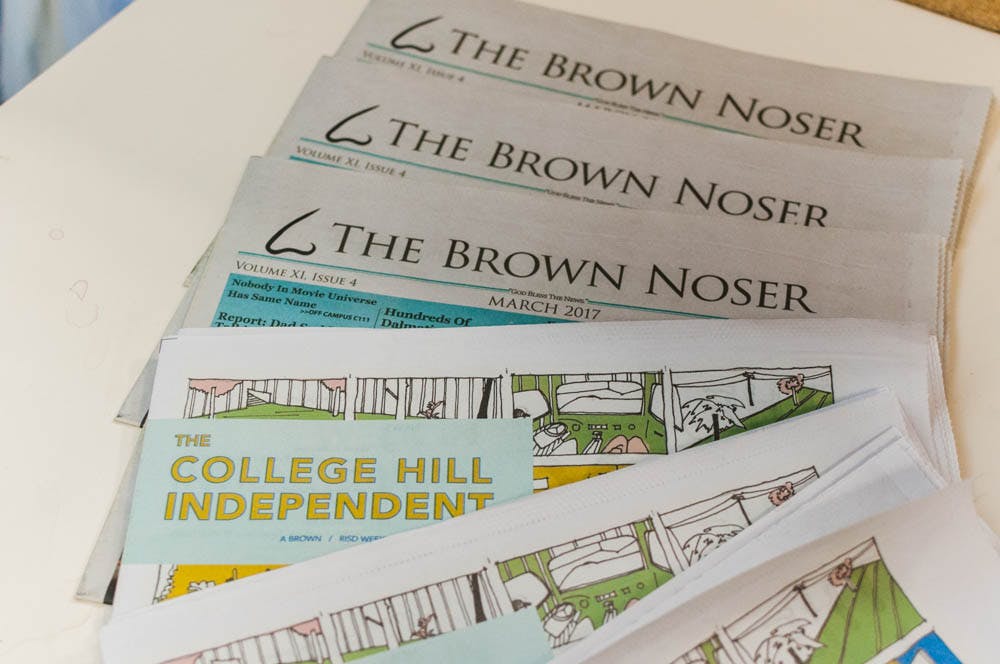In a budget review for the 2017-18 academic year, the Undergraduate Finance Board did not approve funding that would cover student publications’ printing expenses for the spring 2018 semester, according to sources from several publications. UFB informed student publications of the cuts April 17.
It remains unclear to the leadership of the publications whether UFB will permanently reject all printing costs for the spring or readdress the issue at a later date.
Kelton Ellis ’18, co-managing editor of the College Hill Independent weekly newspaper, said the “problem here is that there’s been a real lack of transparency overall — so much of this has just been cast upon us.”
The editors of the Brown Noser reacted similarly: The cuts were “very out of the blue,” said Katherine Dunham ’19, editor-in-chief of the Brown Noser.
UFB’s budget is comprised of the student activities fee, which is automatically collected from every undergraduate student. The fee in the 2016-17 academic year was $137 per semester. Each student group categorized under the Undergraduate Council of Students is assigned a UFB representative responsible for reviewing their budget request.
For many student publications, printing costs comprise the vast majority of their budget.
The Indy’s “printing costs are about 90 percent of our funding,” said Dolma Ombadykow ’17, co-managing editor of the Indy.
The Clerestory Journal of the Arts’ 2017-18 budget request reveals the journal’s cost of printing amounts to 99 percent of its total budget, according to a copy of the journal’s budget request obtained by The Herald. The remaining 1 percent of its budget is for publicity efforts, such as posters. Only half of the funding the Clerestory Journal requested for the academic year was approved, according to the document, which will cover printing costs for the fall semester.
Similarly, the Intercollegiate Finance Journal received only 2 percent of the budget it requested for spring 2018, according to a copy of the IFJ’s budget request obtained by The Herald.
Editors from multiple publications referred to meetings they had with their UFB representative in the past several weeks in which the cuts were not explicitly mentioned.
In informal meetings with the UFB representative assigned to the Clerestory Journal, Jeremy Wolin ’19, co-managing editor of the Clerestory Journal, was informed of UFB’s intention to make all student publications switch from printing to digital. He was told that if he felt strongly about the need for a print medium, he should express that feeling in the budget request, which he did.
To emphasize the need for printing, the Clerestory Journal wrote in its budget request: “Publishing series of pieces is the best way of displaying the work students have done. … In order to most effectively feature student artists, we publish our issues in physical and color copies.”
“Because there is such a huge design community at Brown and (the Rhode Island School of Design), … the physical printed book is really important to the identity of the magazine,” Wolin said.
Concurrently, in recent semesters, UFB cut all the Indy’s funding for off-campus distribution, which “came with no heads-up whatsoever, which was extremely difficult to manage,” said Will Tavlin ’17.5, the Indy’s co-managing editor.
A core function of the Indy is “to be in print and distributed throughout Providence,” Ombadykow said. “Our aim is to be as accessible to the Providence community as possible.”
The editors expressed frustration not only at the decision to not approve funding for printing but also at how UFB announced its decision.
“To have (our printing funds) turned around on us, without a heads-up or without any sort of caution, is irresponsible, and it feels like the carpet was pulled out from under our feet,” Ombadykow said.
If UFB doesn’t fund the Indy’s print and distribution, “then we see no reason in continuing to be affiliated with Brown … because, financially, we would be completely abandoned at that point,” Ombadykow noted, adding that though that may not be UFB’s intention, “that’s the reality of what UFB is trying to do.”
Other publications also emphasized the importance of printing physical copies as a means of building relationships with the community and with their readers.
Being a print magazine is “a completely different experience” than publishing online, said Katharine Jessiman-Ketcham ’18, president of IFJ. “When we actually print out the journal, we have a distribution day, and it rallies everybody together. It’s a celebration day.”
Distribution is similarly a big deal for the Noser, which has been publishing in print for over 10 years, Dunham said.
Students working on VISIONS Magazine also noted a connection with its print readers. The relationship online readers have with a publication is different than its relationship with its print readers, said Mia Gold ’17, editor-in-chief of VISIONS Magazine. “I hope that print publications continue to be valued at Brown, even though we’re moving towards a digital age.” Gold said. “Continuing to fund publications is really important for Brown.”
Chair of UFB Jordan Ferguson ’17 declined to comment. UFB will meet to discuss the matter with student publications April 25, according to multiple sources.
Correction: A previous version of this article said the Brown Noser has been publishing in print for over 20 years. In fact, the Noser was founded in 2006 and has been publishing for over 10 years. The Herald regrets the error.





